- 8777701917
- info@saikatinfotech.com
- Basirhat W.B

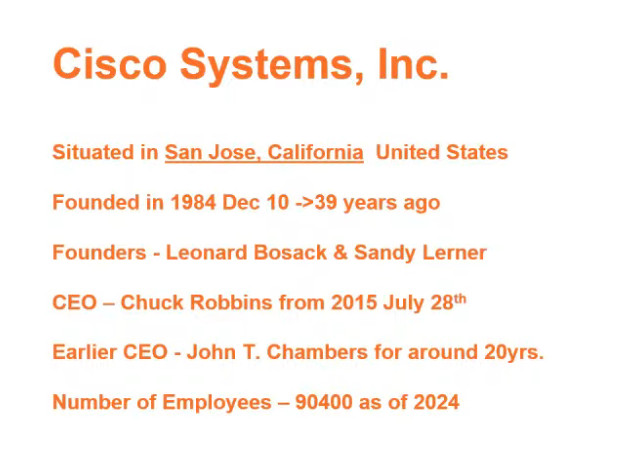
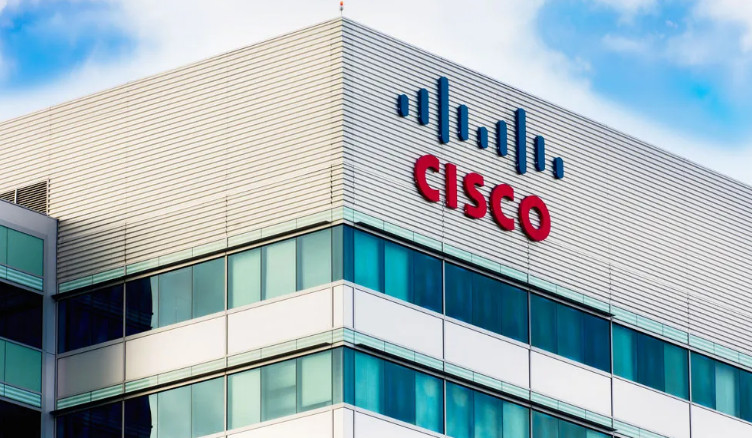

About Cisco
Cisco is widely recognized as a leading developer of networking hardware and telecommunications equipment, forming the backbone of the internet’s infrastructure and enterprise connectivity. Over decades, Cisco has played an instrumental role in enabling internet functionality, from small networks to global systems, providing the essential technology that powers secure and reliable communication across industries. The company’s platforms, including WebEx for video conferencing and Cisco Jabber for messaging and collaboration, have become key tools in the modern workspace, facilitating real-time communication for millions of users worldwide.
Beyond traditional networking, Cisco is also a major force in the fast-evolving Internet of Things (IoT) sector. Its IoT solutions span connected devices, data processing, and analytics, which help organizations gather and leverage vast amounts of real-time data from connected systems. Cisco’s founders, Sandy Lerner and Leonard Bosack, laid the groundwork for this connectivity by pioneering the Local Area Network (LAN) concept — an innovation that transformed internal business communications.
Today, Cisco’s contributions to network technology continue to support seamless communication, secure data transfer, and efficient operations across the world, from large enterprises to small businesses.
Cisco’s company history
Both were involved with the university’s computing facilities. Bosack realized that the existing router technology developed in the 1970s by other Stanford students could be used to connect their offices together. Lerner and Bosack were instrumental in developing what we know today as Local Area Networks (LANs). The couple saw the commercial possibilities for other businesses, and ultimately founded Cisco Systems Inc, taking its name from their base in San Francisco.
Cisco enters the market
1985 saw the sale of Cisco’s first product, consisting of a router that could support multiple networks, to Digital Equipment Corporation. After an injection of venture capital, the company went public in 1990 under the tenure of John Morgridge, who became CEO in 1988.
Across the 1990s, Cisco embraced IP (Internet Protocol). The acquisition of companies like Crescendo Communications and Kalpana further strengthened Cisco’s portfolio, allowing the company to offer a comprehensive range of networking solutions.
During this period, Cisco introduced the Cisco 7000 series router, a powerful and modular platform that became a cornerstone for large-scale networking deployments. The Cisco 2500 series router also became very popular as it allowed all businesses, no matter their size, to access the burgeoning internet.
In the 1990s, Cisco also developed the Catalyst series of switches and acquired StrataCom, which strengthened Cisco’s expertise in wide-area networking. In 1995, John T. Chambers took over as CEO.
What does Cisco sell?
Cisco’s initial product lineup started with dedicated network nodes like the Cisco 2500 series, evolving into more advanced models such as the Cisco 7000 and 8500 series. Nowadays, Cisco’s offerings encompass a wide range of networking and IT solutions suitable for businesses of various sizes.
The company is known for its networking hardware, including routers, switches, and wireless systems, with notable products like the Cisco Catalyst series switches and ISR routers forming the core of enterprise networks. Alongside these, Cisco provides cyber security solutions, such as Cisco SecureX and Cisco Umbrella, which help organisations protect against cyber threats.
Cisco also focuses on data centre technologies with products like the Unified Computing System (UCS) and Nexus switches, designed to support modern data centre and cloud environments. In addition, their collaboration tools, including WebEx and Cisco Jabber, facilitate communication and productivity. The company’s innovation extends to AI and IoT, integrating these technologies into their solutions to meet the demands of the tech landscape.
Cisco has further enhanced its offerings with Cisco Intersight, a cloud-based management platform for data center and edge environments. Intersight leverages AI and machine learning to provide proactive insights, predictive analytics, and recommendations, helping IT teams address issues before they affect operations. The move was seen as a way for Cisco to double-down on its goal of providing resilient, intelligent infrastructure that adapts to the needs of modern businesses, enabling them to scale and innovate with confidence.
Cisco was founded in 1984 by husband and wife Sandy Lerner and Leonard Bosack, who were computer scientists at Stanford University. The founding management team also included Kirk Lougheed, Greg Satz, and Richard Troiano, who were instrumental in the company’s early development.
In 1990, Cisco went public and John Morgridge was appointed CEO. Under his leadership, the company experienced significant growth. In 1995, John Chambers succeeded Morgridge as CEO, steering the company through the internet boom and establishing Cisco as a dominant player in the networking industry.
Today, Chuck Robbins serves as CEO and chairman, a role he assumed in 2015. Robbins has steered Cisco through the digital transformation era, emphasizing growth areas such as cyber security, IoT, cloud computing, and software-as-a-service (SaaS) offerings. His leadership has focused on modernizing Cisco’s business model through increased investments in software and recurring revenue streams, positioning the company to meet the demands of a connected, cloud-driven world.
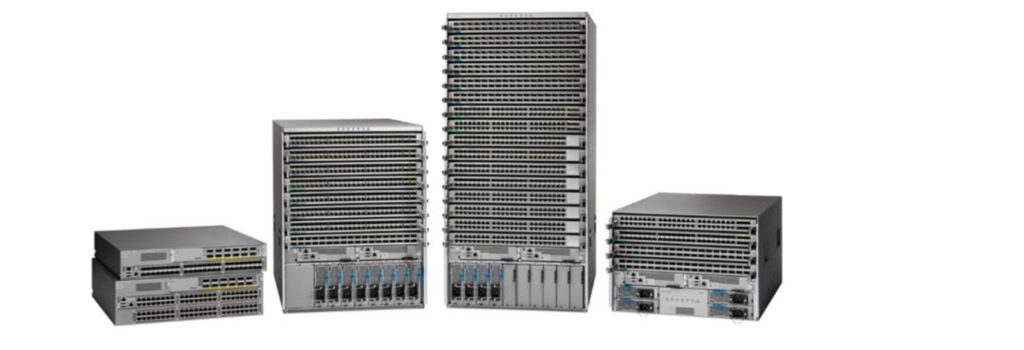

Cisco Nexus 7000 Series Switch:
Cisco Nexus 7000 Series Switches combine high levels of scalability with operational flexibility. They provide the foundation for Cisco Unified Fabric. They are a modular data center-class product line designed for highly scalable 1/10/40/100 Gigabit Ethernet networks with a fabric architecture that scales beyond 17 terabits per second (Tbps). Designed to meet the requirements of the most mission-critical data centers, the switches deliver continuous system operation and virtualized, pervasive services. The Cisco Nexus 7000 Series is based on the proven Cisco NX-OS Software operating system, with enhanced features to deliver real-time system upgrades with exceptional manageability and serviceability.
The first in the next generation of switch platforms, the Cisco Nexus 7000 Series provides integrated resilience combined with features optimized specifically for the data center for availability, reliability, scalability, and ease of management.
Main benefits
Coupled with Cisco NX-OS, the Cisco Nexus 7000 Series delivers a comprehensive set of features with nonstop operation in four chassis form factors:
All Cisco Nexus 7000 Series chassis use a passive mid-plane architecture, providing physical connectors and copper traces for interconnecting the fabric modules and the I/O modules for direct data transfer. All intermodule switching is performed via the crossbar fabric ASICs on the individual I/O modules and fabric modules. In the case of Cisco Nexus 7004 chassis, since there are no fabric modules, the mid-plane provides the connectors and traces to interconnect the fabric ASICs on the I/O modules directly.
A scalable, fully distributed fabric architecture composed of up to five fabric modules combined with the chassis midplane delivers up to 550 Gbps per slot for 8.8 Tbps, 9.9 Tbps, and 18.7 Tbps of forwarding capacity in the 9-slot, 10-slot, and 18-slot switches, respectively. The 4-slot chassis delivers up to 1.92 Tbps of forwarding capacity in combination with the built-in fabric system.
The midplane design on the 9-slot, 10-slot, and 18-slot chassis and the backplane design on the 4-slot chassis support flexible technology upgrades as your needs change, providing ongoing investment protection.
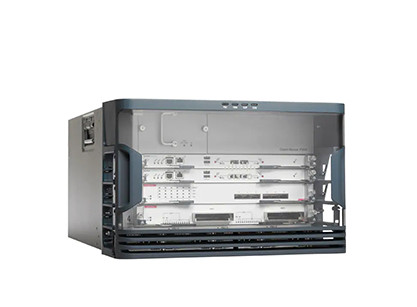
Cisco Nexus 7000 4-Slot Switch Chassis
The Cisco Nexus 7000 4-Slot chassis with two I/O module slots supports up to 96 x 1 and 10 Gigabit Ethernet ports, 12 x 40 Gigabit Ethernet ports and 4 x 100 Gigabit Ethernet ports, meeting the needs of small to medium-size data centers, co-locations, access- and aggregation-layer deployments, high-speed core deployments, and smaller operation zones. The Cisco Nexus 7000 4-Slot chassis also has two dedicated supervisor slots to provide full redundancy and high availability. The 4-slot chassis does not require fabric modules. The local I/O module fabrics are connected back to back to form a two-stage crossbar that interconnects the I/O modules and the supervisor engines. The backplane capacity is determined by the installed I/O modules.
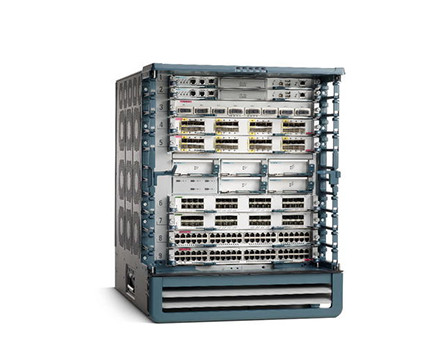
Cisco Nexus 7000 9-Slot Switch Chassis
The Cisco Nexus 7000 9-Slot chassis with up to seven I/O module slots supports up to 336 x 1 and 10 Gigabit Ethernet ports, 42 x 40 Gigabit Ethernet ports, and 14 x 100 Gigabit Ethernet ports, meeting the demands of mission-critical campus core and data center deployments. It has two dedicated supervisor slots to provide full redundancy.
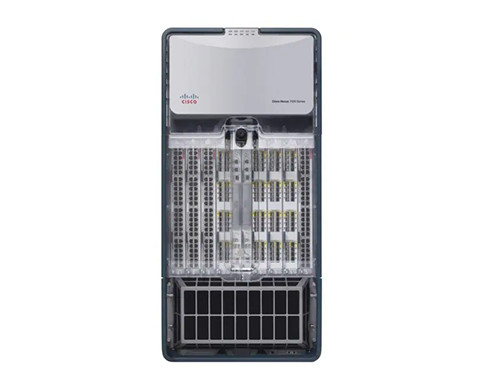
Cisco Nexus 7000 10-Slot Switch Chassis
The Cisco Nexus 7000 10-Slot chassis with up to eight I/O module slots supports up to 384 x 1 and 10 Gigabit Ethernet ports, 48 x 40 Gigabit Ethernet ports, and 16 x 100 Gigabit Ethernet ports, meeting the demands of large data center deployments. It has two dedicated supervisor slots to provide full redundancy.
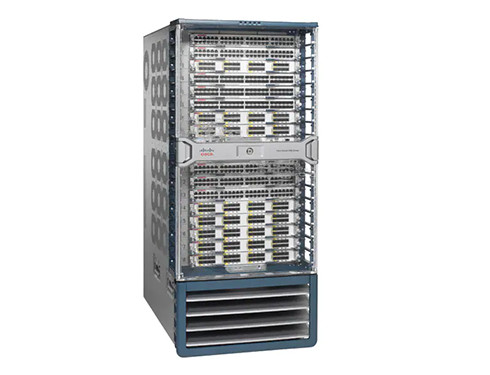
Cisco Nexus 7000 18-Slot Switch Chassis
The Cisco Nexus 7000 18-Slot chassis with up to 16 I/O module slots supports up to 768 x 1 and 10 Gigabit Ethernet ports, 96 x 40 Gigabit Ethernet ports, and 32 x 100 Gigabit Ethernet ports, meeting the demands of the largest data center deployments. It has two dedicated supervisor slots to provide full redundancy.
Features and Benefits
Coupled with Cisco NX-OS, the Cisco Nexus 7000 Series delivers a comprehensive set of features with nonstop operation in four chassis form factors:
All Cisco Nexus 7000 Series chassis use a passive mid-plane architecture, providing physical connectors and copper traces for interconnecting the fabric modules and the I/O modules for direct data transfer. All intermodule switching is performed via the crossbar fabric ASICs on the individual I/O modules and fabric modules. In the case of Cisco Nexus 7004 chassis, since there are no fabric modules, the mid-plane provides the connectors and traces to interconnect the fabric ASICs on the I/O modules directly.
A scalable, fully distributed fabric architecture composed of up to five fabric modules combined with the chassis midplane delivers up to 550 Gbps per slot for 8.8 Tbps, 9.9 Tbps, and 18.7 Tbps of forwarding capacity in the 9-slot, 10-slot, and 18-slot switches, respectively. The 4-slot chassis delivers up to 1.92 Tbps of forwarding capacity in combination with the built-in fabric system.
The midplane design on the 9-slot, 10-slot, and 18-slot chassis and the backplane design on the 4-slot chassis support flexible technology upgrades as your needs change, providing ongoing investment protection.
Cisco Nexus 7000 Series Chassis Common Components
All Cisco Nexus 7000 Series chassis have the following components:
Energy-Efficient Design
The Cisco Nexus 7000 Series uses power supplies that are up to 90 percent efficient, so less power is wasted as heat, and more power is available for the system to use than with typical power supplies.
The fan modules in the chassis adjust to compensate for changing thermal characteristics. At lower speeds, they use less power. In the 9-slot chassis, the fan tray is designed to completely turn off the power for a row of fans when the corresponding slots are unused.
Consolidation of multiple switches in the Cisco Nexus 7000 Series is enabled by the powerful combination of high density and performance, support for device virtualization, and comprehensive reliability and availability features. This consolidation increases the power efficiency by reducing wasted power from multiple partially loaded and inflexible systems.
| Model | Cisco Nexus 7000 4-Slot Switch | Cisco Nexus 7000 9-Slot Switch | Cisco Nexus 7000 10-Slot Switch | Cisco Nexus 7000 18-Slot Switch |
|---|---|---|---|---|
| Product compatibility | Supports all Cisco Nexus 7000 Series Supervisor and I/O modules except the following: N7K-SUP1 N7K-M132XP-12 N7K-M148GS-11 N7K-M148GT-11 N7K-F132XP-15 Does not use fabric modules | Supports all Cisco Nexus 7000 Series Supervisor and I/O modules Supports Fabric2 modules Does not support Fabric1 modules | Supports all Cisco Nexus 7000 Series Supervisor and I/O modules Supports Fabric1 and Fabric2 modules | Supports all Cisco Nexus 7000 Series Supervisor and I/O modules Supports Fabric1 and Fabric2 modules |
| Max local switching capacity | 600 Gbps | 600 Gbps | 600 Gbps | 600 Gbps |
| Max inter-slot switching capacity | 440 Gbps | 550 Gbps | 550 Gbps | 550 Gbps |
| Software compatibility | Cisco NX-OS Software Release 6.1(2) or later | Cisco NX-OS Software Release 5.2 or later | Cisco NX-OS Software Release 4.0 or later | Cisco NX-OS Software Release 4.1 or later |
| Options | Lockable front module door | Lockable front module door | Air filter Lockable front module doors | Lockable front module door |
| Performance | 1.44 billion packets per second (bpps) (IPv4 unicast) in combination with supervisor module and built-in fabric | 5.04 bpps (IPv4 unicast) in combination with supervisor and fabric modules | 5.76 bpps (IPv4 unicast) in combination with supervisor and fabric modules | 11.5 bpps (IPv4 unicast) in combination with supervisor and fabric modules |
| Reliability and availability | Online insertion and removal (OIR) of all redundant components: supervisor modules, power supplies, and fan trays | OIR of all redundant components: supervisor and fabric modules, power supplies, and fan trays | OIR of all redundant components: supervisor and fabric modules, power supplies, and fan trays | OIR of all redundant components: supervisor and fabric modules, power supplies, and fan trays |
| MIBs | Supports Simple Network Management Protocol (SNMP) Versions 3, 2c, and 1 (see Cisco NX-OS Software release notes for details about specific MIB support) | Supports SNMPv3, v2c, and v1 (see Cisco NX-OS Software release notes for details about specific MIB support) | Supports SNMPv3, v2c, and v1 (see Cisco NX-OS Software release notes for details about specific MIB support) | Supports SNMPv3, v2c, and v1 (see Cisco NX-OS Software release notes for details about specific MIB support) |
| Network management | Cisco Data Center Network Manager (DCNM) 6.1.(2) or later | Cisco DCNM 5.2 or later | Cisco DCNM 4.0 or later | Cisco DCNM 4.1 or later |
| Programming interfaces |
|
|
|
|
| Physical specifications |
|
|
|
|
| Environment | ||||
| Airflow direction | Side to rear | Side to side | Bottom front of chassis to top back | Side to side |
| Operating temperature | 32 to 104°F (0 to 40°C) | |||
| Operating relative humidity | 5 to 90%, noncondensing | |||
| Operating altitude | -500 to 13,123 ft. (agency certified 0 to 6500 ft.) | |||
| Seismic | Zone 4 per GR63 | |||
| Floor loading | 42 lb. per sq. ft. | 104 lb. per sq. ft. | 190 lb. per sq. ft. | 190 lb. per sq. ft. |
| Operational vibration | GR63, Section 5.4.2 ETS 300 019-1-3, Class 3.1, Section 5.5 | |||
| Storage altitude | -1000 to 30,000 ft. | |||
| Storage temperature | -40 to 158°F (-40 to 70°C) | |||
| Storage relative humidity | 5 to 95%, noncondensing | |||
| Heat dissipation | Maximum 3500W per chassis (actual dissipation will be lower, depending on the chassis configuration) | Maximum 7500W per chassis (actual dissipation will be lower, depending on the chassis configuration) | Maximum 12,000W per chassis (actual dissipation will be lower, depending on the chassis configuration) | Maximum 18,000W per chassis (actual dissipation will be lower, depending on the chassis configuration) |
| Regulatory Standards Compliance | ||||
| Regulatory compliance |
| |||
| Environmental standards |
| |||
| Safety |
| |||
| Warranty | Cisco Nexus 7000 Series Switches come with the standard Cisco 1-year limited hardware warranty | |||